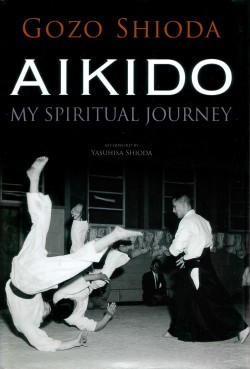
塩田剛三の『Aikidō – my spiritual journey』を読みました。『合気道修行』と『合気道人生』の本が組み立て音訳したほんです。全然面白かったです。
I have read Aikidō – my spiritual journey by Gozo Shioda, this is the translation and assembly of the books Aikidō Shugyo and Aikidō Jinsei. Extremely interesting.
J’ai lu le livre Aikidō – my spiritual journey de Gozo Shioda, c’est l’assemblage et la traduction des livres Aikidō Shugyo Aikidō Jinsei. Une lecture très intéressante.
Gozo Shioda
Foreword: Yasuhisa Shioda
Translators: Jacques Payet & Christopher Johnston
Kodansha USA
ISBN: 978-1-56836-411-7
Gozo Shioda was among the earliest students of Morihei Ueshiba, the founder of Aikidō. He trained with o-Sensei before the war, and founded his own dōjō, Yoshinkan, in 1955. This book gives an overview of Shioda’s perception of aikidō, and what he learnt from Ueshiba.
While there was always a mystical component to aikidō, and the book’s title suggest something mystical, Shioda appears as a very pragmatic person, explaining his experiences, how they relate to the various aspects of aikidō, and the teachings of o-sensei. The book reminded me a lot of the Book of Five Rings, with its no nonsense approach to Būdo, and the ideas are pretty consistent: the plan of no-plan, de-emphasising techniques and an insisting on the importance of a good posture. The book also has five chapters.
Besides the principle of Aikidō, the book, through its anecdotes, gives a glimpse into the adventures of Morihei Ueshiba in Mongolia, which sound like something you could do an adventure movie out, but also the rough relationship between dōjō before the war, the scuffles with the yakusa, it felt like a grimmer version of Ranma ½.
Yoshinkan is known as the aikidō that is taught to the japanese cops, and reading this book, you understand why, this is the aikidō that branched off when o-sensei was young, the practice rough, and japan very disorganised. There is certainly a huge effort to change a mystical experience into something structured that can be taught, even while admitting that techniques are not the real thing.
While certain ideas, like the fact that aikidō is 70% atemi would probably make my teachers cringe, nothing written in the book feels inconsistent with the practice I have done. Shioda admits that he really understood aikidō when he was in a fight in China, and wonder how people living in less troubled times will get that experience, but I felt no regret, no nostalgia, just a teacher pondering on some fact and how to teach best in those circumstances.
One section I found very interesting is Shioda explaining why there is no competition, as this is one thing that sets aikidō apart from other martial arts, like Judō or Karate. He makes a pretty good point that a sport cannot be a martial art, as competition will always impose rules that warp the martial idea. I also found interesting the fact he stated there would be not static principles that would be repeated often, something I experienced during my short practice of Shōlin-ji kempō.
The text is pretty short, 200 pages including ≈15 pages of afterword by Gozo Shioda’s son, Yasuhisa, which I found moderately interesting. One thing I must say is that the paper and the printing are gorgeous, making it a pleasure to read.
All in all I found this to be an excellent book about aikidō, which gives a pretty sharp picture of the characters and the idea that underlines this martial art, certainly a much more concrete narrative than what I read in the Shambhala Guide to Aikidō or the Wikipedia. I really recommend this book if you are interested in aikidō, in particular the non mystical parts, and I think it is a worthy read, even if you are training in other branch of aikidō, like I do.
